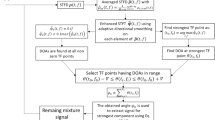Abstract
In the past, prestack Gaussian beam migration adopted the steepest descent approximation to reduce the dimension of the integrals and speed up the computation. However, the simplified formula by the steepest descent approximation was still in the frequency domain, and it had to be evaluated at each frequency. To solve this problem, we present a fast algorithm by changing the order of the integrals. The innermost integral is regarded as a two-dimensional continuous function with respect to the real part and the imaginary part of the total traveltime. A lookup table corresponding to the value of the innermost integral is constructed at the sampling points. The value of the innermost integral at one imaging point can be obtained through interpolation in the constructed lookup table. The accuracy and efficiency of the fast algorithm are validated with the Marmousi dataset. The application to the Sigsbee2A dataset shows a good result.
Similar content being viewed by others
References
Alkhalifah T., 1995. Gaussian beam depth migration for anisotropic media. Geophysics, 60, 1474–1484.
Bleistein N. and Gray S.H., 2010. Amplitude calculations for 3D Gaussian beam migration using complex-valued traveltimes. Inv. Probl., 26, 85017–85044.
Casasanta L. and Gray S.H., 2015. Converted-wave beam migration with sparse sources or receivers. Geophys. Prospect., 63, 534–551.
Červený V., Popov M.M. and Pšenčík I., 1982. Computation of wave fields in inhomogeneous media-Gaussian beam approach. Geophys. J. R. Astron. Soc., 70, 109–128.
Gray S.H., 2005. Gaussian beam migration of common-shot records. Geophysics, 70, S71–S77.
Gray S.H. and Bleistein N., 2009. True-amplitude Gaussian-beam migration. Geophysics, 74, S11–S23.
Hale D., 1993a. Migration by the Kirchhoff, Slant Stack, and Gaussian Beam Methods. Report 126. Center for Wave Phenomena, Colorado School of Mines, Golden, CO.
Hale D., 1993b. Computational Aspects of Gaussian Beam Migration. Report 127. Center for Wave Phenomena, Colorado School of Mines, Golden, CO.
Han F., Sun J. and Yang H., 2008. Ray-tracing of wavefront construction by bicubic convolution interpolation. J. Jilin Univ. (Earth Sci. Edition), 38, 336–340, 346.
Hill N.R., 1990. Gaussian beam migration. Geophysics, 55, 1416–1428.
Hill N.R., 2001. Prestack Gaussian-beam migration. Geophysics, 66, 1240–1250.
Hu H., Liu Y., Zheng Y., Liu X. and Lu H., 2016. Least-squares Gaussian beam migration. Geophysics, 81, S87–S100.
Leveille J.P., Jones I.F., Zhou Z., Wang B. and Liu F., 2011. Subsalt imaging for exploration, production, and development: A review. Geophysics, 76, WB3–WB20.
Paffenholz J., 2001. Sigsbee2 synthetic subsalt data set: Image quality as function of migration algorithm and velocity model error. http://citeseerx.ist.psu.edu/viewdoc/download?doi=10.1.1.453.4606&rep=rep1&type=pdf.
Popov M.M., 1982. A new method of computation of wave fields using Gaussian beams. Wave Motion, 4, 85–97.
Popov M.M., Semtchenok N.M., Popov P.M. and Verdel A.R., 2010. Depth migration by the Gaussian beam summation method. Geophysics, 75, S81–S93.
Versteeg R., 1994. The Marmousi experience: Velocity model determination on a synthetic complex data set. The Leading Edge, 13, 937–936.
Yadari N.E., 2015. True-amplitude vector-acoustic imaging: Application of Gaussian beams. Geophysics, 80, S43–S54.
Yue Y.B., Li Z.C., Qian Z.P., Zhang J.L., Sun P.Y. and Ma G.K., 2012. Amplitude-preserved Gaussian beam migration under complex topographic conditions. Chinese J. Geophys., 55, 1376–1383 (in Chinese).
Zhu T., Gray S.H. and Wang D., 2007. Prestack Gaussian-beam depth migration in anisotropic media. Geophysics, 72, S133–S138.
Author information
Authors and Affiliations
Corresponding author
Rights and permissions
About this article
Cite this article
Gao, Z., Sun, J., Sun, H. et al. A fast algorithm for prestack Gaussian beam migration adopting the steepest descent approximation. Stud Geophys Geod 61, 575–586 (2017). https://doi.org/10.1007/s11200-016-0929-y
Received:
Revised:
Accepted:
Published:
Issue Date:
DOI: https://doi.org/10.1007/s11200-016-0929-y



